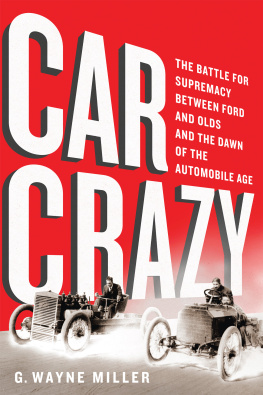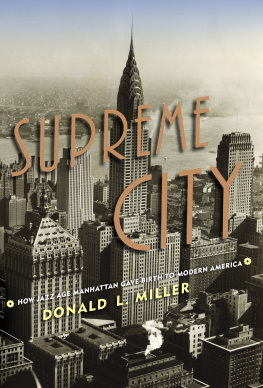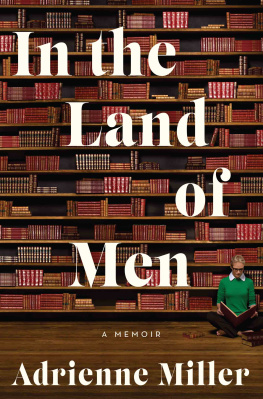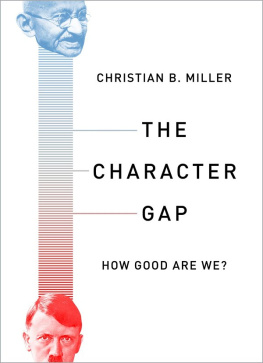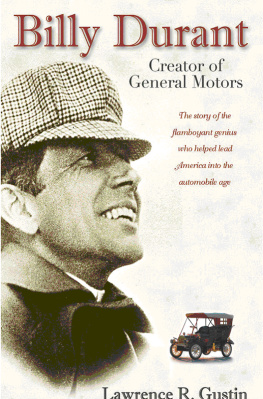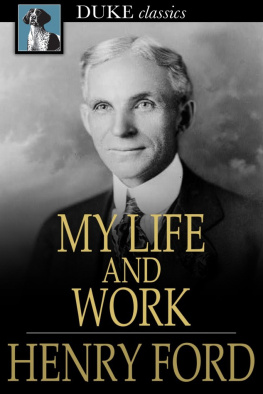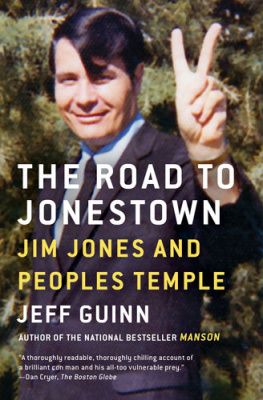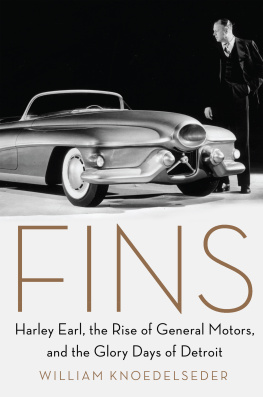Car Crazy
Also by G. Wayne Miller
The Work of Human Hands: Hardy Hendren and Surgical Wonder at Childrens Hospital
Coming of Age: The True Adventures of Two American Teens
Toy Wars: The Epic Struggle Between G.I. Joe, Barbie and the Companies That Make Them
King of Hearts: The True Story of the Maverick Who Pioneered Open Heart Surgery
Men and Speed: A Wild Ride Through NASCARs Breakout Season
The Xeno Chronicles: Two Years on the Frontier of Medicine Inside Harvards Transplant Research Lab
An Uncommon Man: The Life and Times of Senator Claiborne Pell
Top Brain, Bottom Brain: Harnessing the Power of the Four Cognitive Modes (with Stephen M. Kosslyn, PhD)
Copyright 2015 G. Wayne Miller
Published in the United States by PublicAffairs, a Member of the Perseus Books Group
All rights reserved.
Printed in the United States of America.
No part of this book may be reproduced in any manner whatsoever without written permission except in the case of brief quotations embodied in critical articles and reviews. For information, address PublicAffairs, 250 West 57th Street, 15th Floor, New York, NY 10107.
PublicAffairs books are available at special discounts for bulk purchases in the U.S. by corporations, institutions, and other organizations. For more information, please contact the Special Markets Department at the Perseus Books Group, 2300 Chestnut Street, Suite 200, Philadelphia, PA 19103, call (800) 810-4145, ext. 5000, or e-mail .
Book Design by Trish Wilkinson Set in 11 point Minion Pro
Library of Congress Cataloging-in-Publication Data
Miller, G. Wayne, author.
Car crazy : the battle for supremacy between Ford and Olds and the dawn of the automobile age / G. Wayne Miller. First edition.
pages cm
Includes bibliographical references and index.
ISBN 978-1-61039-551-9 (hardcover) ISBN 978-1-61039-552-6 (e-book) 1. Ford, Henry, 18631947. 2. Ford Motor Company. 3. Ford Model T automobileHistory. 4. Olds, Ransom Eli, 18641950. 5. General Motors Corporation. Oldsmobile DivisionHistory. 6. Oldsmobile autom obileHistory. 7. Automobile industry and tradeUnited StatesHistory. 8. Automobile industry and tradeUnited StatesManagement. I. Title.
TL215.F7M53 2015
338.4'7629222097309041dc23
2015024477
First Edition
10 9 8 7 6 5 4 3 2 1
To my late mother-in-law, Daisy Gabrielle, a woman of great kindness, courage, and wisdom. Daisy was filled with humor and grace. Being with her was always magical.
Contents
The Carmakers
Karl Friedrich Benz , German engineer, inventor, and manufacturer
Roy D. Chapin , Oldsmobile sales chief and test driver; founder of Hudson Motor Car Company
James J. Couzens , Ford Motor Company secretary
William Crapo Billy Durant , creator of General Motors
Charles E. and J. Frank Duryea , builders of the first US production car
Henry Ford , founder of Ford Motor Company
Edward S. Spider Huff , Fords brilliant but bedeviled leading engineer
mile Levassor , founder of French pioneer auto company Panhard et Levassor
Alexander Y. Malcomson , early partner of Henry Ford
Ransom Eli Olds , founder of Oldsmobile
Frederic L. Smith , secretary-treasurer of Oldsmobile
The Drivers
Tom Cooper , a winner on the track who died in a midnight race through Central Park
Dwight B. Huss , one of two men who competed in historys first race across the continent
Webb Jay , whose racing career ended when he crashed his steam car, Whistling Billy
Ernest D. Keeler , a young racing star who died in a crash three days after Cooper
Percy F. Megargel , a writer and romantic who raced Huss from Manhattan to Oregon, then made the first winter and double-continental crossing, from New York to the West Coast and back
Barney Oldfield , greatest race-car driver of the early era... and maybe ever
The Mechanics
David F. Fassett , rode with Megargel on the winter crossing
Barton Stanchfield , rode with Megargel during the cross-continent race
Milford Wigle , rode with Huss during the cross-continent race
The Patent Players
Frederick P. Fish , president of AT&T and lawyer for the anti-Ford side
Charles M. Hough , judge who decided the Selden suit
Walter C. Noyes , judge who decided the Selden suit on appeal
George B. Selden , who claimed in a US patent to have invented the automobile
Ralzemond B. Parker , battled-hardened lawyer hired to defend Ford in the Selden suit
The Good Roads Evangelists
James W. Abbott , official with the Federal Highway Administrations precursor agency
Albert Augustus Pope , bicycle- and carmaking magnate
Isaac B. Potter , editor, engineer, and lawyer
Roy Stone , first head of the US Office of Road Inquiry
The Scoundrels
Lone John , a lunatic Wyoming shepherd
Big Nose George Parrott , an outlaw who met a most bizarre fate
The Road Hog , any of various anti-car farmers
The ruffians , lads, and men in New York who stoned evil motorists
Edward R. Thomas , wealthy Manhattan heir and murderous driver
S ince my first car , an old black Ford sedan that I drove in high school, I have owned more than ten automobiles. That qualifies me as a motorist, but until this book, I was not alone in believing the US car industry essentially began with Henry Fords Model T, introduced in 1908. I thought that iconic vehicle and a few others made by a handful of fellow manufacturers began the profound transformation of American society that has culminated in our way of life today.
The Model T indeed was revolutionarybut it wasnt first. Oldsmobile founder Ransom Eli Olds built his first car, a three-wheeled thing steered with a tiller and powered by a steam engine, in 1887. The first US vehicle intended for sale was demonstrated in 1893, in Springfield, Massachusetts. Ford drove the first automobile he made, a boxlike contraption on big bicycle tires, through the streets of Detroit in 1896. Many others in America and Europe, where the auto industry really began, were also building carsor planning to. Then, between 1900 and 1908, more than five hundred domestic carmakers went into business. Competition was brutal. The vast majority of firms failed. And a colorful cast of characters abounded: heroes, villains, schemers, and visionariesthe people who imagined a wondrous future with the automobile. That future, as we know today, was both blessing and curse.
By the dawn of what would be called the American Century, the car was already causing unprecedented turmoiland it intensified during that first decade of the 1900s, the period I primarily chronicle in this book. Car enthusiasts battled car-haters in courts, in legislatures, and on the roads. Farmers, spooked by the evil new machines, defended their terrified horsessometimes with shotguns and threats of murder. Motorists ridiculed the horse as filthy and useless, and the old-fashioned farmer as ignorant. Rowdies stoned Gilded Age aristocrats as they flaunted their high-priced imports on the streets of Manhattan. The police chase, the hit-and-run, and the fatal accident became staples of a dramatic new journalistic genre.
The car warsbetween one manufacturer and another; one driver and another; between pedestrian and horse and machine; between bucolic past and engine-powered futureplayed out in the trade journals and the general-circulation newspapers, in the countryside and in urban centers, in most states and in many cities, especially New York City, the early heart of the car market and the nations media capital, then as now.

